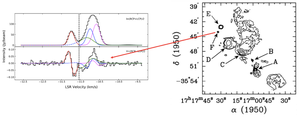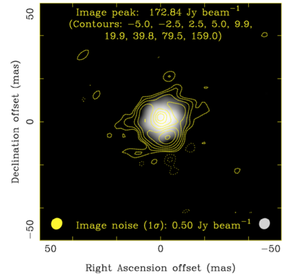Star and Planet Formation and Evolution, and the Search for Life

The NRAO facilities are uniquely suited for the study of stars, star formation, and planet formation. ALMA and the VLA remain the primary tools for imaging planet formation in proto-planetary disks, while the VLBA has produced the first images of what are likely aurorae and radiation belts associated with a low mass brown dwarf, possibly indicating strong star-planet interaction.
Magnetic fields play an important role in star formation, but direct measurements remain scarce. The VLA has demonstrated a new method to measure magnetic fields in star forming clouds using the Zeeman effect in the 38.3 and 38.5 GHz Class II methanol (CH3OH) masers (as opposed to the classic 6.7 GHz methanol masers). Zeeman measurements of the massive star forming region NGC 6334 find magnetic fields in the range 8 to 46 mG. Since Class II methanol masers are radiatively pumped close to the protostar, occurring in the accretion disk or the interface between the disk and outflow regions, such fields have significant impact on the dynamics of these disks (Figure 5; Momjian and Sarma 2023).

ALMA has observed the star-forming region W75N(B), containing the massive protostars VLA1, VLA2, and VLA3. VLA2 is an enigmatic protostar associated with a wind-driven H2O maser shell, which has evolved from an almost isotropic outflow to a collimated one in just 20 years, with the shell expansion halted by an obstacle located to the northeast. ALMA observations of the 1.3 mm continuum and H2CO and SiO emission show a region of ∼30” (∼39,000 AU) diameter, with 40 compact continuum sources, including VLA1, VLA2, and VLA3. The H2CO emission is mainly distributed in a fragmented structure around the three massive protostars. The SiO is highly concentrated on VLA2, indicating the presence of very strong shocks generated near this protostar. The SiO emission is resolved into an elongated structure (0.6”x 0.3”) perpendicular to the major axis of the wind-driven maser shell. The structure and kinematics of the SiO emission are consistent with a toroid and a wide-angle outflow surrounding a central mass of ∼10 M⊙, thus supporting previous theoretical predictions regarding the evolution of the outflow (Figure 6; Gomez et al. 2023).

R Lep is a Mira-type Red Giant variable star, with a period of 445 days at a distance of 471 pc (Figure 7; Asaki et al. 2023). ALMA was used in 2021 to image the carbon-rich evolved star in Bands 8–10 (397–908 GHz) with baselines up to 16 km. The goal was to validate the calibration, using band-to-band phase referencing with a close phase calibrator. Diffraction limited resolution images were made up to the highest frequencies with resolutions of 5mas, thereby demonstrating the potential for ALMA to perform very high resolution imaging with the longest baselines at the highest frequencies.
The ALMA large program Complex Organic Molecules in Protostars with ALMA Spectral Surveys (COMPASS) is in progress to study complex organic chemistry in star and planet forming regions, while the ALMA survey to Resolve exoKuiper belt Substructures (ARKS) program is targeting exo-Kuiper belt dust emission.




Connect with NRAO